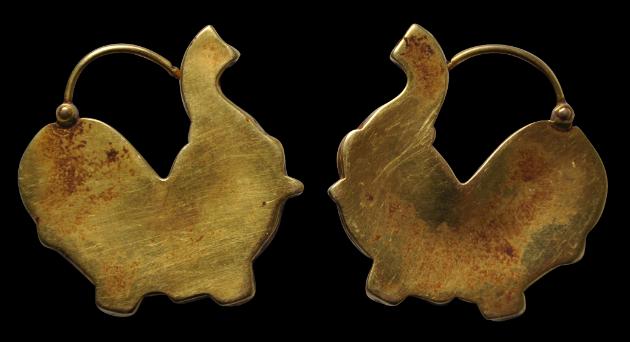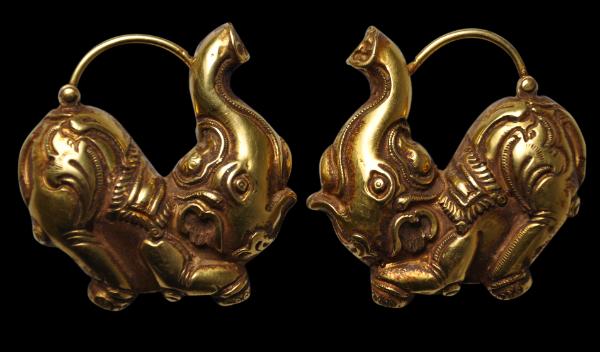
Orissa Gold Earrings
Pair of Gold Makara-shaped Magar Kundal Earrings
Orissa, India
19th century
width of each makara: 4cm, height: 4.3cm, combined weight: 33g
This pair of earrings is of solid gold sheet, hollow, and in the form two makaras – a mythical creature loosely based on a snub-nosed crocodile. The loop closes by springing into a small hole or socket in the body of the earring. The reverse of each earring comprises plain sheet gold.
Such earrings were worn by men across Orissa who had been awarded the right to do so by the local Orissan kings. Those so entitled tended to be from the Brahmin caste and included Purohits (priests), Pandits (those who had mastered the Vedic scriptures and who were usually Brahmin) and particularly esteemed literary figures, artists, singers and actors.
The use of makara imagery is most prevalent in South India, particularly in stonework in temples. But the use of makara for earrings is almost entirely restricted to Orissa (Ganguly, 2007, 2014).
According to research by Waltraud Ganguly, the author of the pre-eminent book on Indian earrings, the use of makara kundal has its origins in the early legends of Orissa. The early kings were said to have given an honorary title and makara kundal earrings to outstanding persons of literature and art. This occurred on the first day of the new year when such artists and literary figures came to give their new year wishes to the local kings. (The bestowal of the title and earrings was equivalent to being knighted and not unlike the New Year’s Honours List that still prevails in the United Kingdom today.) The titles awarded were literary scholar; one proficient in debate; sun among poets; moon among poets. According to one story, those accorded the ‘sun’ and ‘moon’ titles started to argue among themselves as to which was higher leading to the ‘moon’ level leaving the kingdom to seek redress with another king.
The practice of awarding makara kundal continued through the ages, although seems to have ceased at independence when the positions of the hereditary rulers were abolished. But until then, the Orissan kings had their own court-poets, who had daily discussions about literature, music or medicine. Elderly Orissans today can still produce early photographs of their grandfathers and the like who were awarded makara kundal wearing their esteemed earrings.
The earrings are in excellent condition. They are stable and wearable. Traditionally they were won by men, but in a contemporary setting they are of course quite wearable for a woman.
References
Ganguly, W., Earrings: Ornamental Identity and Beauty in India, B.R. Publishing Corporation, 2007.
Ganguly, W., pers. comm., January 2014.
Provenance
private UK collection
Inventory no.: 2473
SOLD



